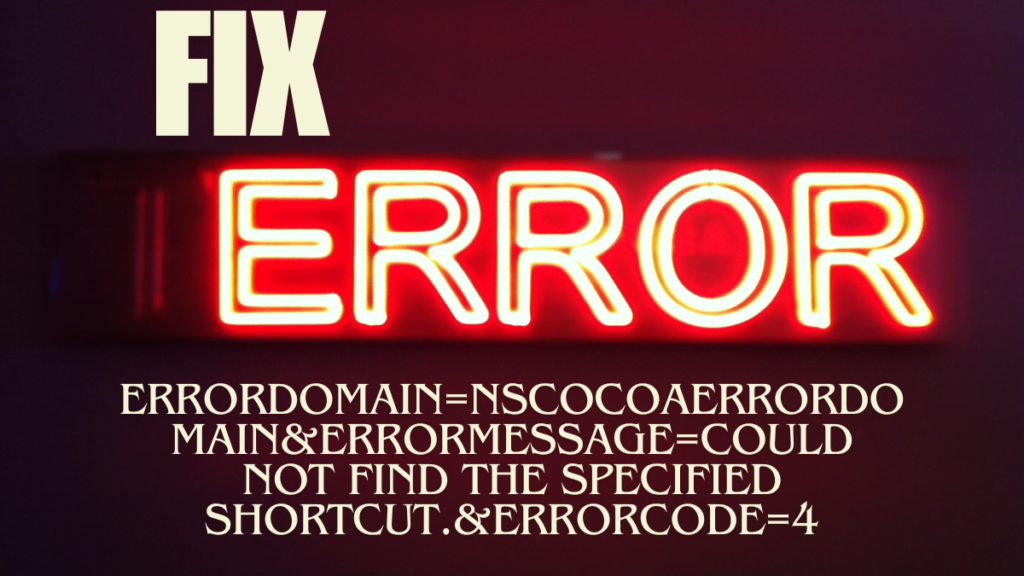In the world of iOS and macOS improvement, encountering mistakes is a not unusual prevalence. Among these, the NSCocoaErrorDomain can be specially complicated. One particular blunders message that builders frequently come upon is: “errordomain=nscocoaerrordomain&errormessage=couldn’t find the required shortcut.&errorcode=4”. This complete guide pursuits to demystify this mistake, imparting you with the essential insights and answers to efficiently tackle it.
Understanding NScocoaerrordomain&errormessage
The NSCocoaErrorDomain is a fundamental errors domain used in Apple’s frameworks, encompassing a wide range of blunders codes related to Cocoa and Cocoa Touch. These mistakes can stand up from issues in record handling, records serialization, utility scripting, and greater. Understanding the shape and nature of these errors is vital for debugging and resolving them efficiently.
Decoding the Error Message
To successfully solve the error “errordomain=nscocoaerrordomain&errormessage=could not discover the specified shortcut.&errorcode=4”, we need to smash it down into its additives:
Error Domain: NSCocoaErrorDomain
Error Message: could not locate the required shortcut
Error Code: 4
Error Code 4 in NSCocoaErrorDomain
Error code four within the context of NSCocoaErrorDomain normally corresponds to a document now not located mistakes. This shows that the machine or software couldn’t find a record or resource that it predicted to discover at a specified course.
Common Causes of the Error
Missing or Moved Files
The maximum straightforward motive of this mistake is that the record or shortcut the application issearching out has been moved or deleted. This can take place due to:
- Manual deletion with the aid of the user
- Changes in file structure in the utility
- Incorrect record paths in the code
Incorrect File Paths
Another not unusual cause is specifying an wrong path within the code. This can arise because of:
- Typographical errors in the record course
- Changes in the listing shape now not meditated inside the code
- Environment-particular direction variations
Insufficient Permissions
In some cases, the file might exist, but the application lacks the necessary permissions to access it. This can be due to:
- File system permissions
- Sandbox restrictions in iOS/macOS
- User privacy settings
How to Resolve the Error
1. Verify the File Path
Start by ensuring that the file path specified in your code is correct. Double-check for any typographical errors or changes in the file structure. You can use debugging tools to print out the file paths and manually verify their existence.
Example:

2. Check File Existence
Ensure that the report or shortcut certainly exists at the desired vicinity. If it’s lacking, you might need to:
- Restore the report from a backup
- Recreate the document if it is an asset or a configuration report
3. Handle File Not Found Gracefully
It’s properly practice to address document not determined errors gracefully within your utility. Provide meaningful mistakes messages to users and offer alternatives to recover or retry the movement.
Example:

4. Update File Paths Dynamically
If your application supports dynamic file paths, ensure they are updated correctly during runtime. This is particularly important for applications that download or generate files on the fly.
Example:

5. Ensure Correct Permissions
Verify that your application has the necessary permissions to access the file. For macOS applications, you may need to check file system permissions, while for iOS, ensure that privacy settings and sandbox rules are correctly configured.
Example:

Preventing Future Errors
- Implement Robust Error Handling
Ensure your utility has robust error coping with mechanisms in region to manipulate record-related mistakes gracefully. This includes imparting fallback alternatives and clear error messages to users. - Regularly Test File Paths
Regularly test and validate report paths at some point of development and before liberating updates. Automated exams can assist trap document direction problems early within the improvement cycle. - Maintain Backups
Encourage customers to maintain backups of vital documents and offer features within your utility to support report recuperation and restoration. - Educate Users
Provide documentation and support to teach customers on how to manage and organize their files effectively. This can assist save you accidental deletions or misplacements that cause mistakes.
Conclusion
Encountering the error “errordomain=nscocoaerrordomain&errormessage=could not discover the required shortcut.&errorcode=four” may be frustrating, however with a systematic technique to troubleshooting and resolving record direction issues, you can reduce disruptions and make certain a smoother consumer revel in. By information the foundation reasons and implementing robust solutions, you could efficaciously save you and control this error on your iOS and macOS programs.
FAQS
What is NSCocoaErrorDomain?
NSCocoaErrorDomain is a domain used by Apple to categorize errors related to the Cocoa and Cocoa Touch frameworks, essential for building apps on macOS and iOS.
How do I locate the shortcut path?
Open the Shortcuts app, navigate to the specific shortcut, and check the actions to ensure they point to the correct files or apps.
What should I do if the error persists?
If the error persists, try advanced troubleshooting steps like analyzing error logs or seeking professional help from Apple Support.
Are third-party tools safe to use?
Yes, as long as you download them from reputable sources and follow the instructions carefully.
Can I prevent this error from happening again?
Yes, by following best practices for managing shortcuts, keeping your apps and iOS updated, and performing regular device maintenance.


2 Comments
Pingback: Ultimate 127.0.0.1:62893 Error Fixed Localhost And Port Number
Pingback: Error Call To A Member Function Getcollectionparentid() On Null Best Guide To Solve 2024